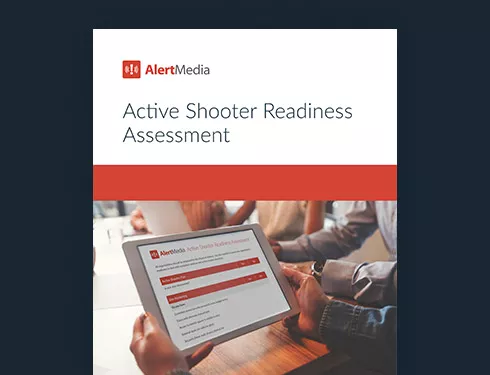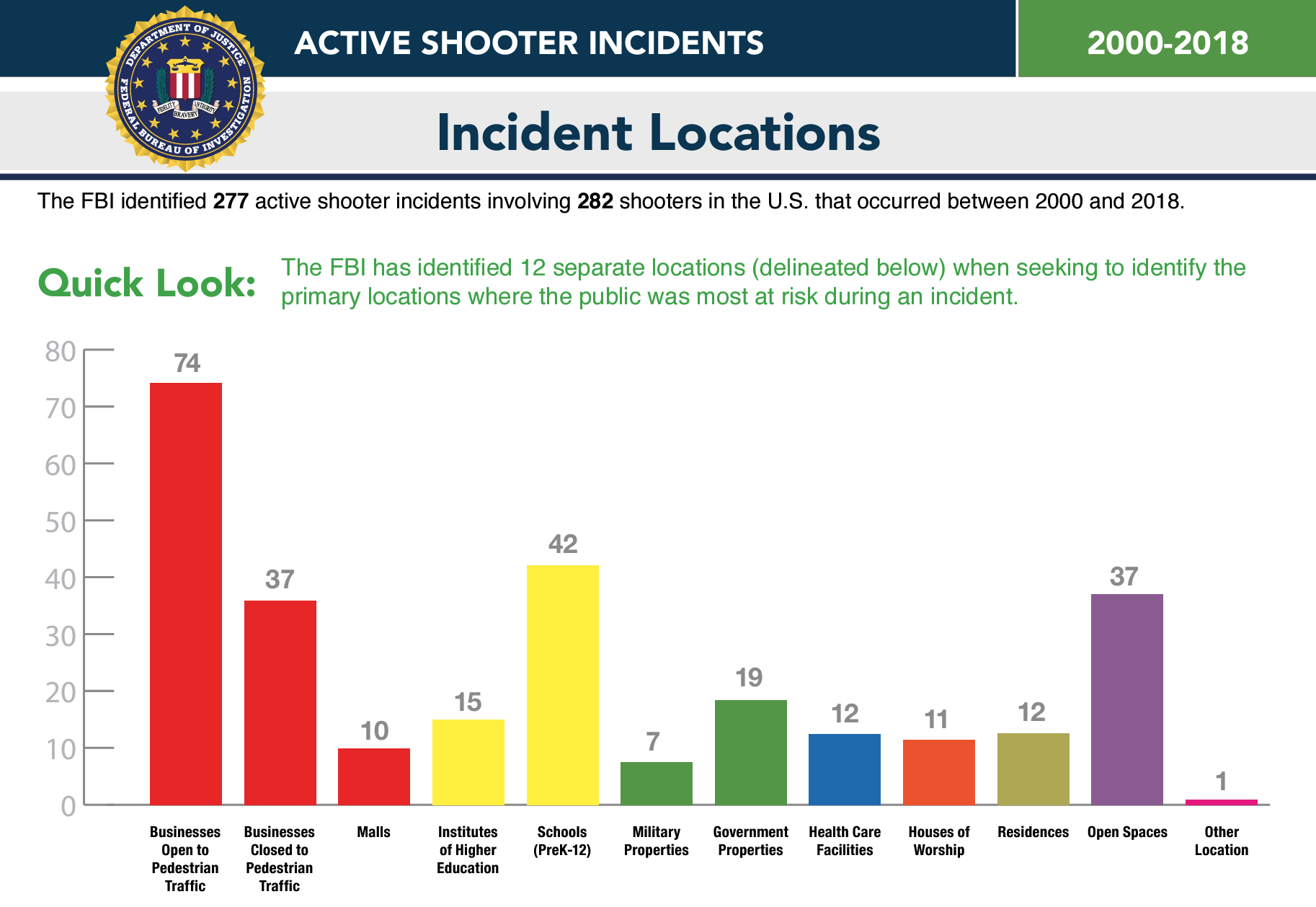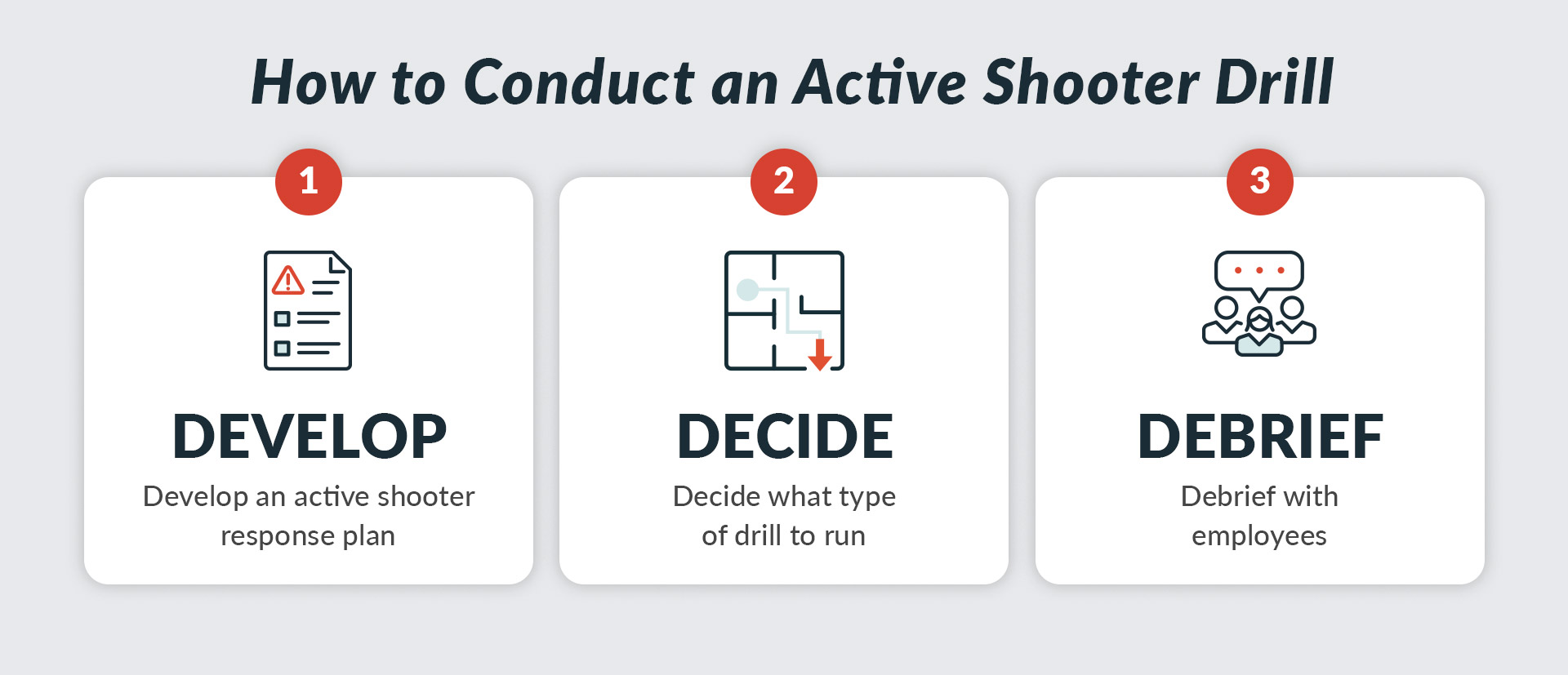
How to Run Active Shooter Drills at Work
Learn about the various types of active shooter drills, pros and cons, and what experts say about emergency preparedness for an active shooter scenario.

Does your organization regularly conduct active shooter drills? If not, it might be time to work it into your preparedness training.
Tragically, gun violence continues to impact American communities across the U.S. In 2023, there were 655 mass shootings. That’s a 96% increase in the five years since 2018 when there were 335 mass shootings in the U.S.
When we think of active shooter events, we typically think of CNN coverage of standoffs with police officers and barricades, violent confrontations in crowded bars, and lasting impressions from highly publicized tragedies—such as the school shooting in Uvalde, Texas, and the attack on concertgoers in Las Vegas, Nevada. These incidents raise impactful and lasting debates about mental health, security, and the well-being of educators, students, and others. Analyzing nationwide active shooter data also highlights that the impact of gun violence is felt broadly and reinforces that active shooter incidents can happen anywhere.
Lawmakers in certain U.S. states, such as California, are taking legal steps to tackle the increase in violence, including rising occurrences of mass shootings. SB 553, signed into law by Governor Gavin Newsom in 2023, establishes new requirements for employers aimed at protecting workers from workplace violence.
According to FBI data, most mass shootings happen in the workplace.

For this article, we are using FBI data to discuss active shooter incidents. The FBI defines an active shooter as “one or more individuals actively engaged in killing or attempting to kill people in a populated area.”
Although no company wants to consider the potential for an active shooter incident at their workplace, accounting for these events in your safety plans has the potential to save lives. In addition to creating an active shooter response plan, law enforcement officers and experts agree that introducing some form of active shooter training at work is best practice and ensures that employees understand what to do when faced with the threat of an armed individual on the premises. Just as fire drills are standard, active shooter preparedness needs to be a part of your emergency action plan (EAP).
Download our Active Shooter Readiness and Drill
This post will examine the various types of active shooter drills, including the pros and cons of each. Finding the appropriate kind of exercise for your business is crucial for protecting your employees. Whether you have remote employees in the vicinity of an active shooter event or your workplace is in direct danger, instituting regular active shooter drills will help prepare your employees to understand what to do.

How to Conduct an Active Shooter Drill at Work
1. Develop a detailed active shooter response plan
Before conducting active shooter drills, your company needs to design a thorough active shooter response plan. While creating this plan, consider potential threats, evacuation routes, and communication methods, among other unique considerations for your business.
As you develop a comprehensive plan for active shooter incidents:
- Conduct a physical security assessment to pinpoint key weaknesses within your workplace
- Train employees to notice and report potential threats
- Create a crisis communication plan (a multichannel two-way emergency communication system makes this easy)
- Identify strategic evacuation routes and shelter locations within the workplace
- Rehearse active shooter drills and lockdown procedures
- Follow up after an incident with a modern employee notification system so you issue updates and determine the safety of all employees
2. Decide what type of drill to run
Lockdown procedure drill
Ever since the threat of nuclear warfare during the Cold War Era, students and adults alike have become familiarized with the lockdown drill. This classic drill has long been implemented as the go-to training method against external threats.
- Secure all exits and windows for an additional barrier to prevent access.
- Block doors, close blinds, and turn off exterior lights to remain inconspicuous.
- Using a mass notification system, notify all your employees of the situation and make sure they are all accounted for.
- Continue regular business activity inside the building, but do not allow anyone to enter the facility.
- Call the police to gather more information about the scenario. Notify authorities of your lockdown status and ask for updates and an all-clear once the situation has ended.
Although this method is still standard in most elementary and secondary schools, it is often ineffective in the workplace. Critics of the lockdown method argue that this form of drill leaves employees as helpless sitting ducks. Since grown adults have a higher capacity to react in the face of danger than young children, this method usually is not the most effective in a business setting.
Despite these downfalls of the lockdown method, staying put and hiding can be the answer in an active shooter situation, especially if the active shooter is off-site but close to the business. If an event unfolds outside your workplace, it is often best to remain in your secure building than to exit into the unknown. By locking up doors, drawing shutters, and turning off lights, you will be safest inside your facility.
The tactical shooter drill
With active shooter events on the rise, specialized services support active shooter drills in workplace settings. These drills are simulations of real-life scenarios with an actor playing the role of a shooter to offer realistic tactical training.
- Contact a professional company that offers tactical shooter training services. These companies typically teach the “run, hide, fight” response by putting employees in a lifelike drill.
- Decide whether a surprise drill or a pre-announced drill best fits the needs of your company. Experts recommend pre-announced exercises to prevent unnecessary psychological trauma.
- Conduct the drill. A designated person, either from an external company or within your own business, will act as an active shooter. The business determines the extent of the role-playing (i.e., actors will shoot blanks or walk around with a fake gun).
- Following the drill, meet with your employees to discuss weaknesses, strategies, and possible improvements.
This is a type of safety drill that offers the most realistic type of training for your employees. This drill is as close as it gets to the real active shooter scenario. By being placed in a controlled, high-pressure situation, employees can learn how to react in high-stress situations, which could end up saving their lives if something were to occur.
Although tactical drills can prove effective in certain scenarios, active shooter drills can also show potential shooters from the company exactly what you would do in an emergency situation. They can use this information to their advantage by blocking major exits or targeting security guards before an attack. Since one in five shootings at work are carried out by employees, this is a significant concern. Critics also argue that such active shooter drills can create a dangerous sense of security and the assumption that all active shooter scenarios are the same. Instead, in an active shooter situation, employees should rely on their intuition and situational awareness to make the best call at the moment.
3. Debrief with employees
Following an active shooter drill, sit down with your employees and reflect upon the training. By debriefing after the drill, your company can identify potential weaknesses in the response plan and strategies to improve. Efficiency is vital in these types of exercises—as it is with real-time emergency responses.
Additionally, you can take a trauma-informed approach to this after-action review to gauge and address any trauma your employees may have faced during the drill. Work with human resources and use feedback to adjust future drills and minimize the impact on employees’ mental state. By providing employees with the proper resources to cope with such factors (tailored to your workplace culture, environment, and individual needs), they will appreciate that your company fulfills its duty of care.
The Debate Surrounding Active Shooter Drills at Work
Before examining various active shooter drill methods, we need to explore the larger debate surrounding these drills. While there is growing support for organizations conducting active shooter training, there are also arguments against active shooter drills in the workplace.
Argument #1: Active shooter incidents are rare, so training isn’t necessary
Even though active shooter events are becoming more common, they are still very rare compared to other threats businesses might face.
Until the mid-2000s, organizations’ physical security efforts primarily focused on preventing theft. However, as the volume of active shooter incidents in the workplace has increased, business leaders have grown increasingly concerned about their physical security and the safety of employees. Recent research found that nearly four in five company leaders feel their organization isn’t fully prepared for an active shooter incident. As a point of comparison, more than 95% of American elementary schools and public high schools have already implemented active shooter drills to enhance school safety, according to a report by Everytown for Gun Safety. Following events like the Sandy Hook Elementary School shooting in Connecticut in 2012, when 6 staff members and 20 kids aged 6–7 were killed, schools have committed to proactive planning and drills. But more mass shootings occur at businesses than K–12 schools, and it’s broadly accepted that the majority of private businesses lack any type of formal active shooter training.
Statistically, your business is much more likely to be impacted by regional hazards, such as a wildfire, hurricane, or severe winter storm than by an active shooter. For that reason, some companies have avoided active shooter training due to concerns about potential psychological stress resulting from these types of emergency drills. These concerns are not without merit.
Argument #2: Active shooter drills put undue mental stress on employees
Mental health professionals have found that active shooter drills in schools have resulted in increases in depression (39%), stress and anxiety (42%), and overall physiological health problems (23%). While much of this research has focused on the impact of active shooter drills in public schools, some employers worry that past trauma may resurface for employees by conducting such exercises, or they might become fearful of coming to work.
Despite the potential for unnecessary trauma, certain businesses deem active shooter preparedness drills as an essential step in preparing for active shooter events. At least 60% of active shooter events end before first responders or local law enforcement even arrive. Ultimately, your business must evaluate its own needs and values to decide the utility of an active shooter drill at your workplace.
Alternatives to an Active Shooter Drill
Active shooters can be countered by methods other than active shooter drills. Alternatives to these drills focus on the prevention and identification of risk factors. For example, situational awareness training helps employees notice warning signs of potentially violent behavior in coworkers. By conditioning your employees to say something if they see something, you decrease the risk of being taken by surprise by a violent act.
Another popular and effective measure to take is increasing your workplace’s physical security. Things like keycard locks, strong doors, and security cameras can provide a physical deterrent and defense against active shooters.
An ounce of prevention is worth a pound of cure—and even more when it comes to workplace violence. The best way to handle an office shooter is to aim to prevent violent actions in the first place. Workplace violence prevention programs focus on creating a harmonious environment where every employee feels welcome and does not tolerate any kind of violence or harassment. Many workplace shootings are preceded by bullying and ostracization, so limiting those feelings can also limit the risk of violence.
Comprehensive Preparedness for Active Shooter Scenarios
Hoping for the best isn’t the same as being prepared. Employees must know how to quickly adapt if a lockdown situation evolves into an evacuation situation. As long as active shooter incidents remain an ongoing risk, they should be factored into your threat assessment programs.
As you assess ways to improve overall preparedness and active shooter emergency plans at your organization, consider a combination of strategies to ensure employees are fully prepared for any active shooter scenario. Finally, by providing employees the time to read informational pamphlets on what to do in active shooter scenarios and rehearsing lockdown and tactical drills, you will further equip them with the knowledge and skills needed to respond.



![Active Shooter Preparedness: How to Protect Your Business [+ Checklist]](https://www.alertmedia.com/wp-content/uploads/2019/04/active-shooter-preparedness-scaled.jpg)
